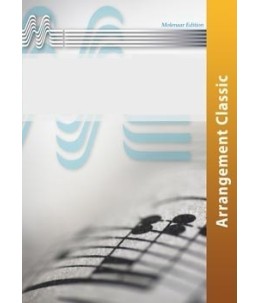
-
Prelude and Fugue BWV 532€ 167,00
Oorspronkelijk voor orgel geschreven en door Ottorino Respighi bewerkt voor symfonie orkest. Bach schreef dit werk in 1710 in de periode dat hij in Weimar verbleef (1709 – 1717). Daar schreef hij in opdracht van de Hertog van Weimar, Wilhelm Ernst, zijn bekendste en belangrijkste orgelwerken.
-
Sarabande€ 70,85
HWV 437
Dit is het vierde deel uit de suite in d-klein (HWV 437) voor solo-klavecimbel. Het werk kreeg grote bekendheid door het instrumentale gebruik in de film Barry Lyndon van Stanley Kubrick uit 1975. Ook Brian De Palma gebruikte dit deel voor de film Redacted uit 2007. -
Bumblebee€ 81,50Euphonium solo
Flight of the Bumblebee was originally composed by Rimsky-Korsakov as an orchestral interlude for his opera The Tale of Tsar Saltan (1899). In the century since its composition, the piece has become a standard showcase for solo instrumental virtuosity. -
-
-
-
-
Symphony n° 1 The Titan€ 499,00
Gustav Mahler’s Symphony No. 1 in D Major, also known as the ‘Titan’ symphony, was primarily composed between the 20th January and the end of March 1888 in Leipzig, although the work also incorporates pre-existing musical themes and ideas from earlier Mahler compositions.
-
Leichtes Blut€ 78,00
Leichtes Blut (Light of Heart), is a polka composed by Johann Strauss II. It is a Schnell-Polka, which was influenced by the galop, a rapid, simple dance in 2/4 meter. The title is difficult to translate, for it suggests an easy-going, light-hearted personality, not simply "thin blood."
-
Bahn frei!€ 78,00
Eduard Strauss is generally viewed as the lesser of the major Strauss family figures; still, like his brothers Johann II and Josef and his father Johann I, he produced some quite popular works.
-
-
Capriccio espagnol€ 217,00
1. Alborada 2. Variazioni 3. Alborada 4. Scena e canto gitano 5. Fandango asturiano
Capriccio espagnol is the common Western title for a five movement orchestral suite, based on Spanish folk melodies, composed by the Russian composer Nikolai Rimsky-Korsakov in 1887. The work has five movements, divided into two parts comprising the first three and the latter two movements respectively.


.png)












